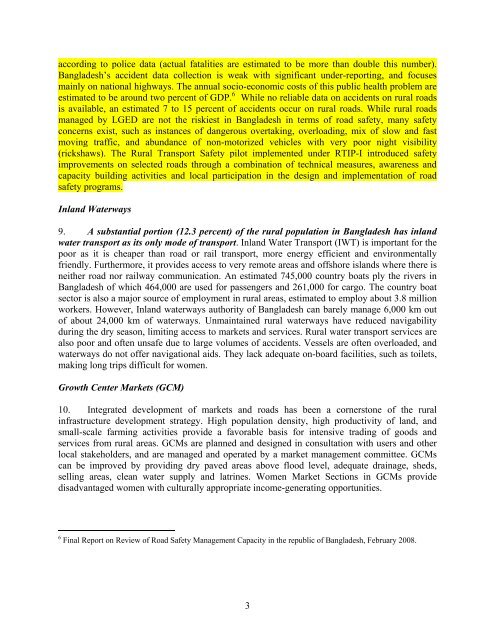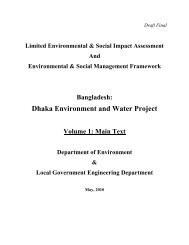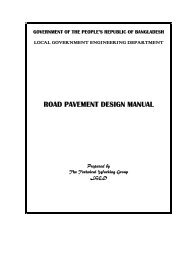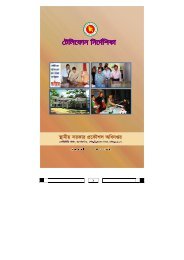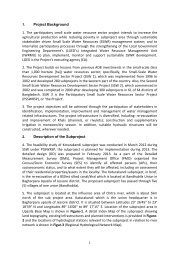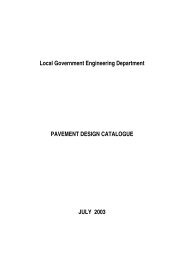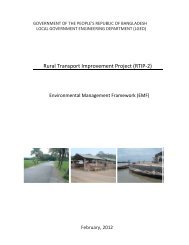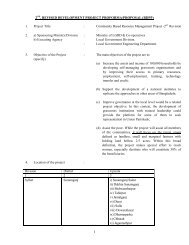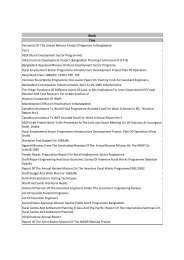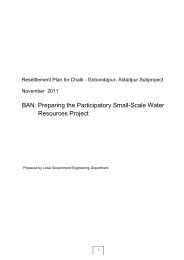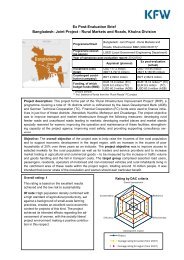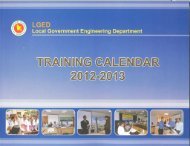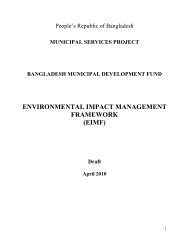PAD - LGED
PAD - LGED
PAD - LGED
Create successful ePaper yourself
Turn your PDF publications into a flip-book with our unique Google optimized e-Paper software.
according to police data (actual fatalities are estimated to be more than double this number).<br />
Bangladesh’s accident data collection is weak with significant under-reporting, and focuses<br />
mainly on national highways. The annual socio-economic costs of this public health problem are<br />
estimated to be around two percent of GDP. 6 While no reliable data on accidents on rural roads<br />
is available, an estimated 7 to 15 percent of accidents occur on rural roads. While rural roads<br />
managed by <strong>LGED</strong> are not the riskiest in Bangladesh in terms of road safety, many safety<br />
concerns exist, such as instances of dangerous overtaking, overloading, mix of slow and fast<br />
moving traffic, and abundance of non-motorized vehicles with very poor night visibility<br />
(rickshaws). The Rural Transport Safety pilot implemented under RTIP-I introduced safety<br />
improvements on selected roads through a combination of technical measures, awareness and<br />
capacity building activities and local participation in the design and implementation of road<br />
safety programs.<br />
Inland Waterways<br />
9. A substantial portion (12.3 percent) of the rural population in Bangladesh has inland<br />
water transport as its only mode of transport. Inland Water Transport (IWT) is important for the<br />
poor as it is cheaper than road or rail transport, more energy efficient and environmentally<br />
friendly. Furthermore, it provides access to very remote areas and offshore islands where there is<br />
neither road nor railway communication. An estimated 745,000 country boats ply the rivers in<br />
Bangladesh of which 464,000 are used for passengers and 261,000 for cargo. The country boat<br />
sector is also a major source of employment in rural areas, estimated to employ about 3.8 million<br />
workers. However, Inland waterways authority of Bangladesh can barely manage 6,000 km out<br />
of about 24,000 km of waterways. Unmaintained rural waterways have reduced navigability<br />
during the dry season, limiting access to markets and services. Rural water transport services are<br />
also poor and often unsafe due to large volumes of accidents. Vessels are often overloaded, and<br />
waterways do not offer navigational aids. They lack adequate on-board facilities, such as toilets,<br />
making long trips difficult for women.<br />
Growth Center Markets (GCM)<br />
10. Integrated development of markets and roads has been a cornerstone of the rural<br />
infrastructure development strategy. High population density, high productivity of land, and<br />
small-scale farming activities provide a favorable basis for intensive trading of goods and<br />
services from rural areas. GCMs are planned and designed in consultation with users and other<br />
local stakeholders, and are managed and operated by a market management committee. GCMs<br />
can be improved by providing dry paved areas above flood level, adequate drainage, sheds,<br />
selling areas, clean water supply and latrines. Women Market Sections in GCMs provide<br />
disadvantaged women with culturally appropriate income-generating opportunities.<br />
6 Final Report on Review of Road Safety Management Capacity in the republic of Bangladesh, February 2008.<br />
3


